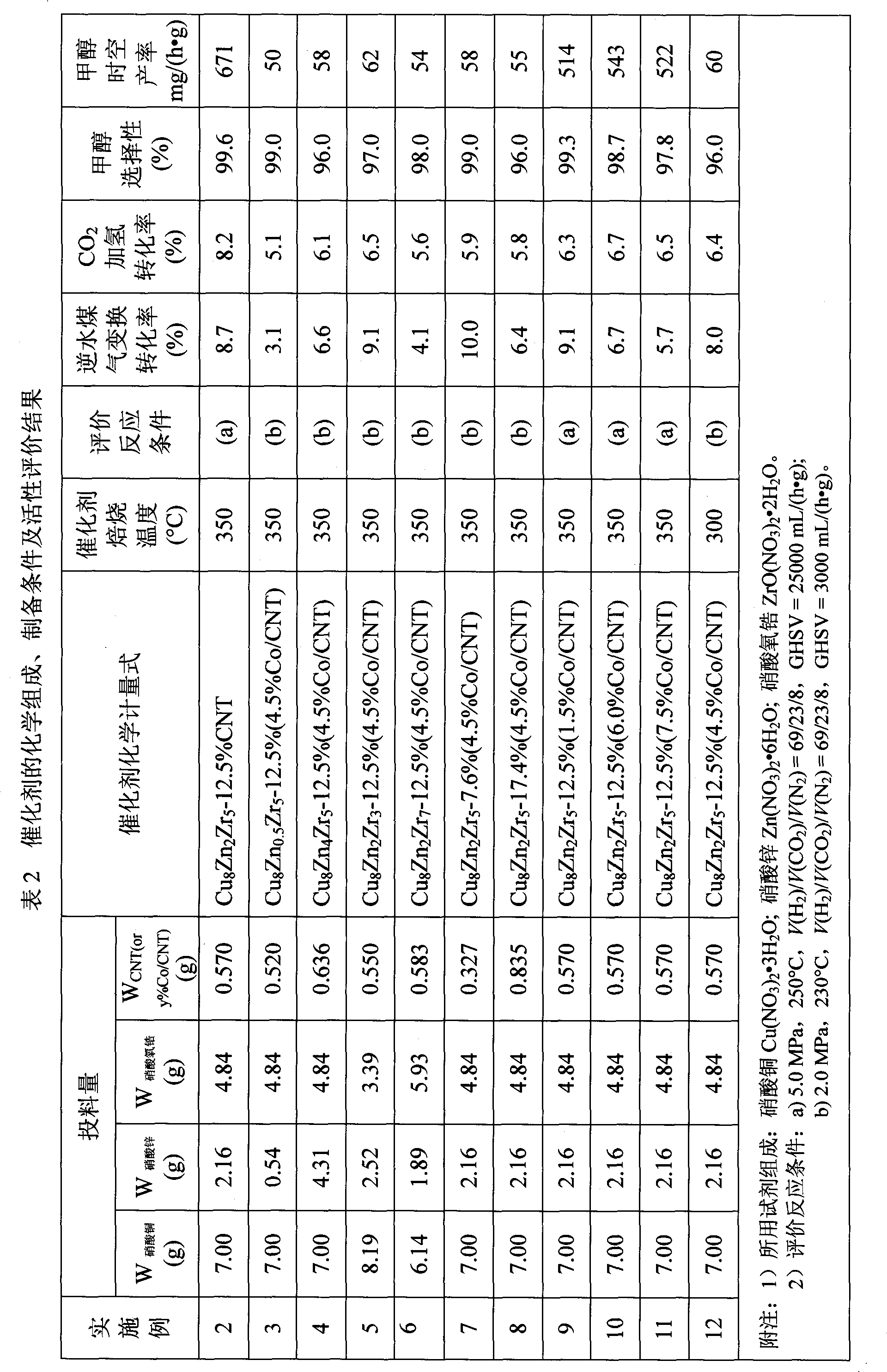Catalyst for hydrogenation of carbon dioxide to generate methanol and preparation method thereof
A carbon dioxide and methanol production technology, which is applied in the direction of metal/metal oxide/metal hydroxide catalyst, organic compound preparation, physical/chemical process catalyst, etc., can solve the problem of low yield of methanol from hydrogenation
- Summary
- Abstract
- Description
- Claims
- Application Information
AI Technical Summary
Problems solved by technology
Method used
Image
Examples
Embodiment 1
[0024] 0.311g of cobalt acetate (Co(CH 3 COO) 2 4H 2 (2, the purity is AR grade) and put into a beaker filled with 50mL ethylene glycol (the purity is AR grade), stir until the cobalt acetate is completely dissolved, add an appropriate amount of KOH aqueous solution (concentration is 4mol / L), to adjust and maintain the concentration of the feed liquid When the pH value is in the range of 9.3 to 9.4, stir for 30 minutes, then add 1.228g of CNT, the feed liquid is ultrasonically treated for 30 minutes, and then placed in a microwave oven (2450MHz, 640W), heated by microwave radiation for 100s, stopped heating for 20s, and then heated for 10s , repeat the operation of "stop heating for 20s and reheat for 10s" once, and then take out the feed liquid and place it in a cold water bath to let it cool rapidly. After filtering, the filter cake is washed with acetone and deionized water successively until the filtrate is neutral. After drying at 110°C, metal Co-modified CNTs were obta...
Embodiment 2
[0032] 7.00g of Cu(NO 3 ) 2 ·3H 2 O, 2.16g Zn(NO 3 ) 2 ·6H 2 O and 4.84g ZrO(NO 3 ) 2 2H 2 O (purity are all AR grade) three mixed, add 100mL deionized water to make solution A; another 5.77g of Na 2 CO 3 (Purity is AR grade) dissolved in 100mL deionized water to make solution B; at 70°C, add solutions A and B at a constant velocity and dropwise into a beaker pre-installed with 0.570g CNT and 200mL deionized water , carry out the co-precipitation reaction at a constant temperature of 70°C, stirring continuously and keeping the pH value of the liquid material layer at about 7.5. , washed with deionized water until the filtrate was neutral, the filter cake was dried at 110°C for 6 hours, pure N 2 Calcined at 350°C for 2 hours in the atmosphere, the stoichiometric formula is Cu 8 Zn 2 Zr 5 - Catalyst (oxidation state) of 12.5% CNT.
[0033]Catalyst to CO 2 The catalytic activity evaluation experiment of methanol hydrogenation is the same as that in Example 1. Th...
Embodiment 3
[0035] 7.00g of Cu(NO 3 ) 2 ·3H 2 O, 0.54g Zn(NO 3 ) 2 ·6H 2 O and 4.84g ZrO(NO 3 ) 2 2H 2 O (purity are all AR grade) three mixed, add 100mL deionized water to make solution A; another 5.19g of Na 2 CO 3 (Purity is AR grade) was dissolved in 100mL of deionized water to make solution B; at 70°C, solutions A and B were added dropwise at a constant rate to 0.520g of 4.5% Co / CNT and 200mL of deionized water In the beaker of ionized water, carry out co-precipitation reaction under the condition of constant temperature of 70°C, constant stirring and keeping the pH value of the liquid material layer at about 7.5. The precipitate was filtered by centrifugation, washed with deionized water until the filtrate was neutral, and the filter cake was dried at 110°C for 6 hours, pure N 2 Calcined at 350°C for 2 hours in the atmosphere, the stoichiometric formula is Cu 8 Zn 0.5 Zr 5 - 12.5% (4.5% Co / CNT) catalyst (oxidation state).
[0036] Catalyst to CO 2 The catalytic acti...
PUM
 Login to View More
Login to View More Abstract
Description
Claims
Application Information
 Login to View More
Login to View More - R&D
- Intellectual Property
- Life Sciences
- Materials
- Tech Scout
- Unparalleled Data Quality
- Higher Quality Content
- 60% Fewer Hallucinations
Browse by: Latest US Patents, China's latest patents, Technical Efficacy Thesaurus, Application Domain, Technology Topic, Popular Technical Reports.
© 2025 PatSnap. All rights reserved.Legal|Privacy policy|Modern Slavery Act Transparency Statement|Sitemap|About US| Contact US: help@patsnap.com


